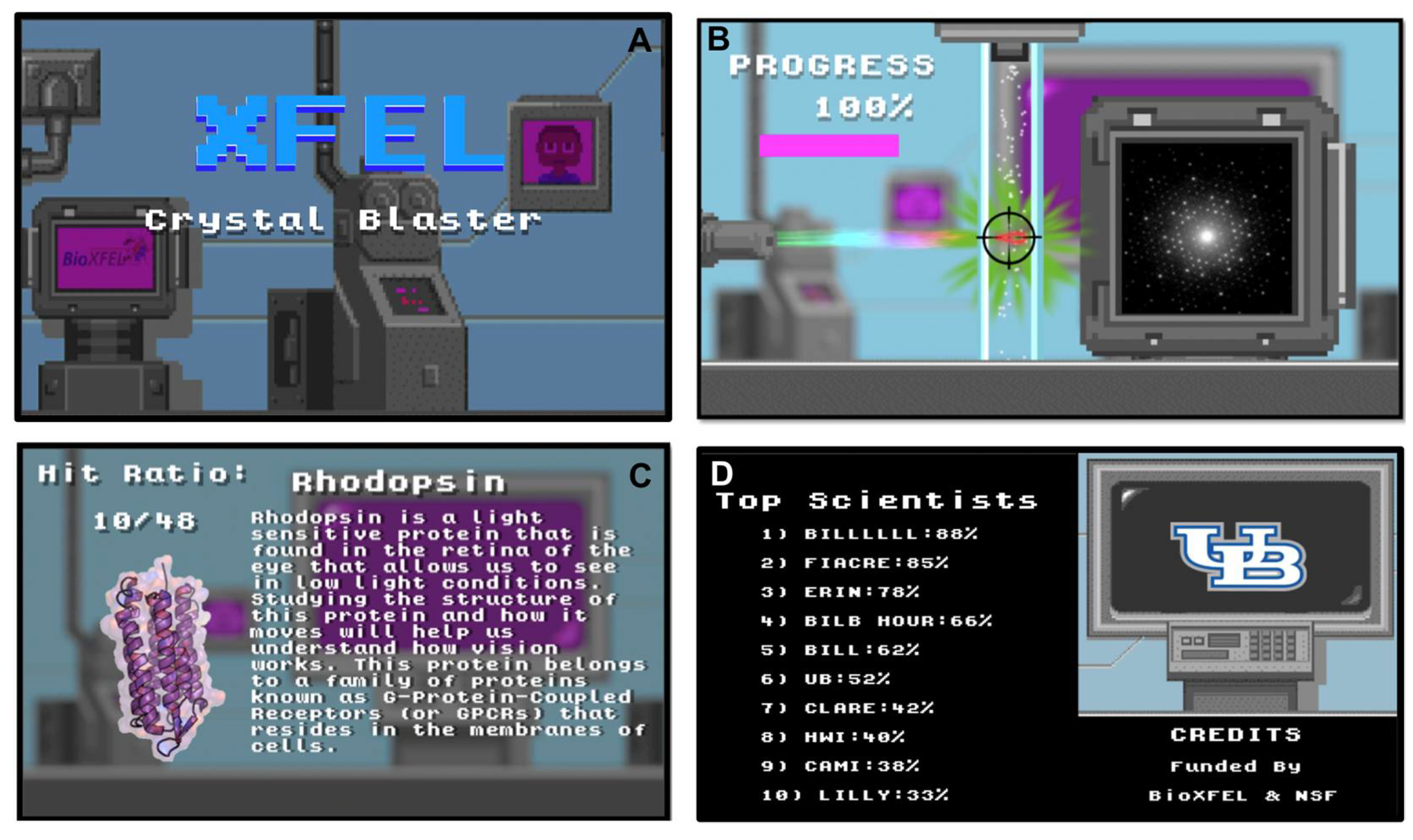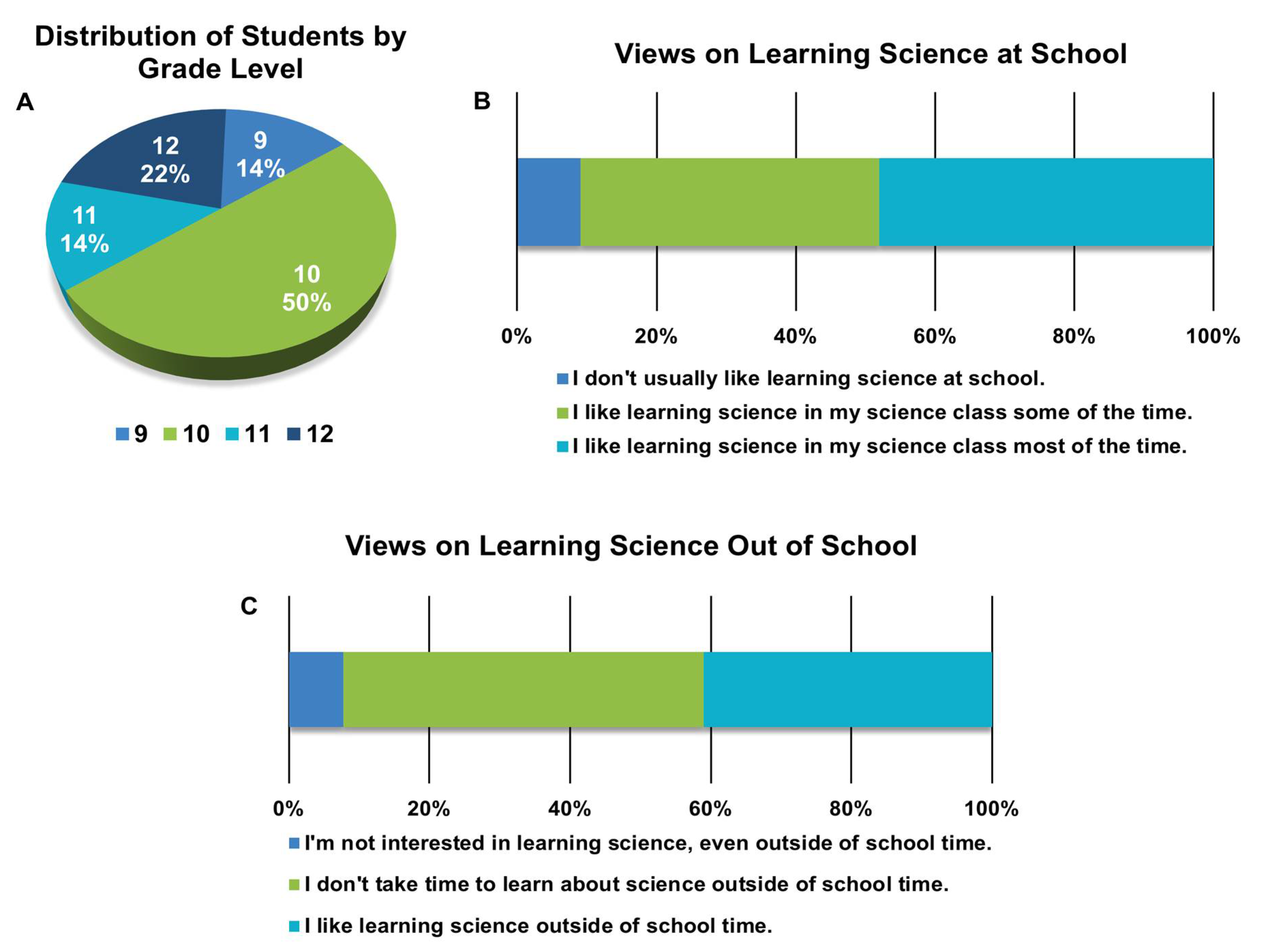The Gamification of XFEL Education Using XFEL Crystal Blaster
Abstract
:1. Introduction
2. Materials and Methods
2.1. Game Design and Creation
2.2. Gameplay
2.3. Implementation
2.4. Game Assessment
3. Results
Assessment Results
4. Discussion
Recent Updates and Future Design
5. Conclusions
Supplementary Materials
Author Contributions
Funding
Institutional Review Board Statement
Informed Consent Statement
Data Availability Statement
Acknowledgments
Conflicts of Interest
References
- White, W.E.; Robert, A.; Dunne, M. The Linac Coherent Light Source. J. Synchrotron Radiat. 2015, 22, 472–476. [Google Scholar] [CrossRef] [PubMed]
- Mills, G.; Bean, R.; Mancuso, A.P. First Experiments in Structural Biology at the European X-ray Free-Electron Laser. Appl. Sci. 2020, 10, 3642. [Google Scholar] [CrossRef]
- Kang, H.-S.; Min, C.-K.; Heo, H.; Kim, C.; Yang, H.; Kim, G.; Nam, I.; Baek, S.Y.; Choi, H.-J.; Mun, G.; et al. Hard X-ray Free-Electron Laser with Femtosecond-Scale Timing Jitter. Nat. Photonics 2017, 11, 708–713. [Google Scholar] [CrossRef]
- Chapman, H.N. Serial Femtosecond Crystallography. Synchrotron Radiat. News 2015, 28, 20–24. [Google Scholar] [CrossRef] [Green Version]
- Brändén, G.; Neutze, R. Advances and Challenges in Time-Resolved Macromolecular Crystallography. Science 2021, 373, eaba0954. [Google Scholar] [CrossRef]
- Šrajer, V.; Schmidt, M. Watching Proteins Function with Time-Resolved X-ray Crystallography. J. Phys. D Appl. Phys. 2017, 50, 373001. [Google Scholar] [CrossRef]
- Martin-Garcia, J.M.; Conrad, C.E.; Coe, J.; Roy-Chowdhury, S.; Fromme, P. Serial Femtosecond Crystallography: A Revolution in Structural Biology. Arch. Biochem. Biophys. 2016, 602, 32–47. [Google Scholar] [CrossRef] [Green Version]
- Caleman, C.; Martin, A.V. When Diffraction Stops and Destruction Begins. In X-ray Free Electron Lasers, A Revolution in Structural Biology; Springer: Cham, Switzerland, 2018; pp. 185–207. [Google Scholar] [CrossRef]
- Beale, J.H.; Bolton, R.; Marshall, S.A.; Beale, E.V.; Carr, S.B.; Ebrahim, A.; Moreno-Chicano, T.; Hough, M.A.; Worrall, J.A.R.; Tews, I.; et al. Successful Sample Preparation for Serial Crystallography Experiments. J. Appl. Crystallogr. 2019, 52, 1385–1396. [Google Scholar] [CrossRef] [Green Version]
- Grünbein, M.L.; Kovacs, G.N. Sample Delivery for Serial Crystallography at Free-Electron Lasers and Synchrotrons. Acta Crystallogr. Sect. D Struct. Biol. 2019, 75, 178–191. [Google Scholar] [CrossRef]
- Kirian, R.A.; Chen, J.P.J.; Spence, J.C.H. Phasing Serial Crystallography Data. In X-ray Free Electron Lasers, A Revolution in Structural Biology; Springer: Cham, Switzerland, 2018; pp. 235–252. [Google Scholar] [CrossRef]
- Liu, H.; Spence, J.C.H. XFEL Data Analysis for Structural Biology. Quant. Biol. 2016, 4, 159–176. [Google Scholar] [CrossRef]
- Orville, A.M. Recent Results in Time Resolved Serial Femtosecond Crystallography at XFELs. Curr. Opin. Struct. Biol. 2020, 65, 193–208. [Google Scholar] [CrossRef] [PubMed]
- Botha, S.; Barends, T.; Kabsch, W.; Latz, B.; Nass, K.; Shoeman, R.; Dworkowski, F.; Panepucci, E.; Wang, M.; Schlichting, I.; et al. Room Temperature Serial Crystallography at Synchrotrons. Acta Crystallogr. Sect. Found Adv. 2014, 70, C326. [Google Scholar] [CrossRef] [Green Version]
- Standfuss, J.; Spence, J. Serial Crystallography at Synchrotrons and X-ray Lasers. Iucrj 2017, 4, 100–101. [Google Scholar] [CrossRef] [PubMed] [Green Version]
- Martin-Garcia, J.M. Protein Dynamics and Time Resolved Protein Crystallography at Synchrotron Radiation Sources: Past, Present and Future. Crystals 2021, 11, 521. [Google Scholar] [CrossRef]
- Bauer, W.J.; Woodruff, S.B. A Science Education Model for Large Collaborative Centers. Struct. Dyn. 2021, 8, 020402. [Google Scholar] [CrossRef] [PubMed]
- Jawad, H.M.; Tout, S. Gamifying Computer Science Education for Z Generation. Information 2021, 12, 453. [Google Scholar] [CrossRef]
- Cornu, B. Digital Natives: How Do They Learn? How to Teach Them? UNESCO Institute for Information Technologies in Education: Moscow, Russian, 2011; Volume 44. [Google Scholar]
- Kalogiannakis, M.; Papadakis, S.; Zourmpakis, A.-I. Gamification in Science Education. A Systematic Review of the Literature. Educ. Sci. 2021, 11, 22. [Google Scholar] [CrossRef]
- Partnerships, T.E. Gamification in Education: What Is It & How Can You Use It? Available online: https://www.trueeducationpartnerships.com/schools/gamification-in-education/#:~:text=Gamification%20theory%20in%20education&text=Gamification%20in%20learning%20involves%20using,information%20and%20test%20their%20knowledge (accessed on 30 March 2022).
- Zhao, D.; Playfoot, J.; Nicola, C.D.; Guarino, G.; Bratu, M.; Salvadore, F.D.; Muntean, G.-M. An Innovative Multi-Layer Gamification Framework for Improved STEM Learning Experience. IEEE Access 2022, 10, 3879–3889. [Google Scholar] [CrossRef]
- Liu, F.-J.; Lu, C.-M. Design and Implementation of a Collaborative Educational Gamification Authoring System. Int. J. Emerg. Technol. Learn. Ijet 2021, 16, 277–289. [Google Scholar] [CrossRef]
- Hursen, C.; Bas, C. Use of Gamification Applications in Science Education. Int. J. Emerg. Technol. Learn. Ijet 2018, 14, 4–23. [Google Scholar] [CrossRef]
- Arruzza, E.; Chau, M. A Scoping Review of Randomised Controlled Trials to Assess the Value of Gamification in the Higher Education of Health Science Students. J. Med. Imaging Radiat. Sci. 2020, 52, 137–146. [Google Scholar] [CrossRef] [PubMed]
- McLaughlin, K.J. Understanding Structure: A Computer-Based Macromolecular Biochemistry Lab Activity. J. Chem. Educ. 2017, 94, 903–906. [Google Scholar] [CrossRef]
- Burley, S.K.; Bhikadiya, C.; Bi, C.; Bittrich, S.; Chen, L.; Crichlow, G.V.; Christie, C.H.; Dalenberg, K.; Costanzo, L.D.; Duarte, J.M.; et al. RCSB Protein Data Bank: Powerful New Tools for Exploring 3D Structures of Biological Macromolecules for Basic and Applied Research and Education in Fundamental Biology, Biomedicine, Biotechnology, Bioengineering and Energy Sciences. Nucleic Acids Res. 2020, 49, D437–D451. [Google Scholar] [CrossRef]
- McDonald, A.R.; Roberts, R.; Koeppe, J.R.; Hall, B.L. Undergraduate Structural Biology Education: A Shift from Users to Developers of Computation and Simulation Tools. Curr. Opin. Struct. Biol. 2022, 72, 39–45. [Google Scholar] [CrossRef] [PubMed]
- Sharp, A.K.; Gottschalk, C.J.; Brown, A.M. Utilization of Computational Techniques and Tools to Introduce or Reinforce Knowledge of Biochemistry and Protein Structure–Function Relationships. Biochem. Mol. Biol. Educ. 2020, 48, 662–664. [Google Scholar] [CrossRef] [PubMed]
- Bitbucket by Atlassian. Available online: https://bitbucket.org (accessed on 30 March 2022).
- Free Sound. Available online: https://freesound.org/ (accessed on 30 March 2022).
- Open Game Art. Available online: https://opengameart.org/ (accessed on 30 March 2022).
- The Spriters Resource. Available online: https://www.spriters-resource.com/ (accessed on 30 March 2022).
- Unity Asset Store. Available online: https://assetstore.unity.com/ (accessed on 30 March 2022).
- Itch.Io-A Web-Based Gaming Platform for Independent Games. Available online: https://itch.io/ (accessed on 30 March 2022).
- Nogly, P.; James, D.; Wang, D.; White, T.; Zatsepin, N.; Shilova, A.; Nelson, G.; Liu, H.; Johansson, L.; Heymann, M.; et al. PDB Entry-4X31-Room Temperature Structure of Bacteriorhodopsin from Lipidic Cubic Phase Obtained with Serial Millisecond Crystallography Using Synchrotron Radiation, New York SGX Research Center for Structural Genomics (NYSGXRC); 2014. Available online: https://www.wwpdb.org/pdb?id=pdb_00004x31 (accessed on 30 March 2022).
- Suga, M.; Akita, F.; Hirata, K.; Ueno, G.; Murakami, H.; Nakajima, Y.; Shimizu, T.; Yamashita, K.; Yamamoto, M.; Ago, H.; et al. PDB Entry-4UB6-Native Structure of Photosystem II (Dataset-1) by a Femtosecond X-ray Laser, New York SGX Research Center for Structural Genomics (NYSGXRC); 2014. Available online: https://www.wwpdb.org/pdb?id=pdb_00004ub6 (accessed on 30 March 2022).
- Pande, K.; Tenboer, J.; Schmidt, M. PDB Entry-5HD5-Femtosecond Structural Dynamics Drives the Trans/Cis Isomerization in Photoactive Yellow Protein: 200 Ns Time Delay Photo-Activated (Light) Structure, New York SGX Research Center for Structural Genomics (NYSGXRC); 2016. Available online: https://www.wwpdb.org/pdb?id=pdb_00005hd5 (accessed on 30 March 2022).
- DeLano, W. The PyMOL Molecular Graphics System; Schrödinger, LLC: New York, NY, USA. Available online: https://pymol.org/2/ (accessed on 30 March 2022).
- Zardecki, C. Gaming Structural Biology for General Audiences. Available online: https://cdn.rcsb.org/rcsb-pdb/general_information/news_publications/newsletters/2019q4/corner.html#three (accessed on 30 March 2022).



Publisher’s Note: MDPI stays neutral with regard to jurisdictional claims in published maps and institutional affiliations. |
© 2022 by the authors. Licensee MDPI, Basel, Switzerland. This article is an open access article distributed under the terms and conditions of the Creative Commons Attribution (CC BY) license (https://creativecommons.org/licenses/by/4.0/).
Share and Cite
Kabayiza, F.; Woodruff, S.B.; Bauer, W.J. The Gamification of XFEL Education Using XFEL Crystal Blaster. Crystals 2022, 12, 671. https://doi.org/10.3390/cryst12050671
Kabayiza F, Woodruff SB, Bauer WJ. The Gamification of XFEL Education Using XFEL Crystal Blaster. Crystals. 2022; 12(5):671. https://doi.org/10.3390/cryst12050671
Chicago/Turabian StyleKabayiza, Fiacre, Sarah B. Woodruff, and William J. Bauer. 2022. "The Gamification of XFEL Education Using XFEL Crystal Blaster" Crystals 12, no. 5: 671. https://doi.org/10.3390/cryst12050671
APA StyleKabayiza, F., Woodruff, S. B., & Bauer, W. J. (2022). The Gamification of XFEL Education Using XFEL Crystal Blaster. Crystals, 12(5), 671. https://doi.org/10.3390/cryst12050671





